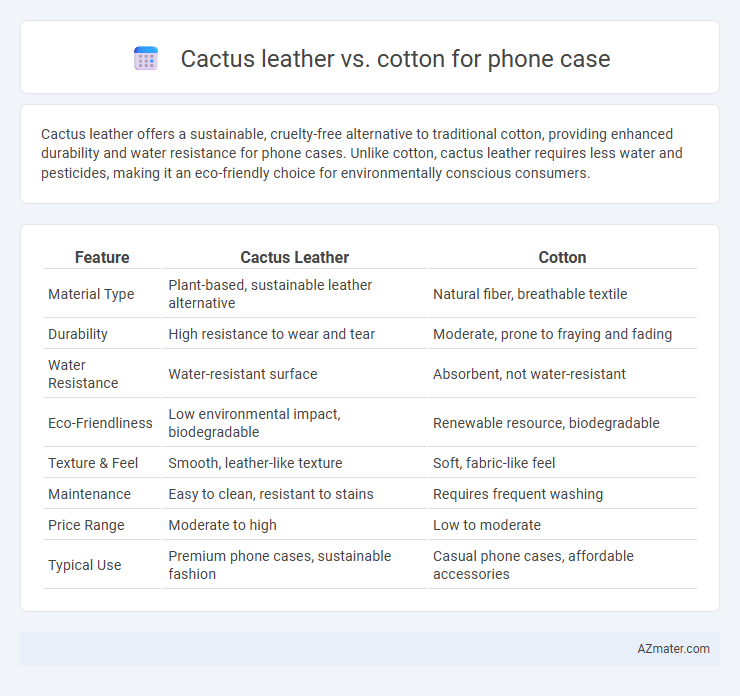Cactus leather offers a sustainable, cruelty-free alternative to traditional cotton, providing enhanced durability and water resistance for phone cases. Unlike cotton, cactus leather requires less water and pesticides, making it an eco-friendly choice for environmentally conscious consumers.
Table of Comparison
| Feature | Cactus Leather | Cotton |
|---|---|---|
| Material Type | Plant-based, sustainable leather alternative | Natural fiber, breathable textile |
| Durability | High resistance to wear and tear | Moderate, prone to fraying and fading |
| Water Resistance | Water-resistant surface | Absorbent, not water-resistant |
| Eco-Friendliness | Low environmental impact, biodegradable | Renewable resource, biodegradable |
| Texture & Feel | Smooth, leather-like texture | Soft, fabric-like feel |
| Maintenance | Easy to clean, resistant to stains | Requires frequent washing |
| Price Range | Moderate to high | Low to moderate |
| Typical Use | Premium phone cases, sustainable fashion | Casual phone cases, affordable accessories |
Introduction to Sustainable Phone Case Materials
Cactus leather offers a durable, eco-friendly alternative to traditional phone case materials by utilizing water-efficient, plant-based resources with significantly lower carbon emissions compared to conventional cotton production. Cotton, while natural and biodegradable, demands extensive water usage and pesticide application, raising environmental concerns throughout its cultivation process. Choosing cactus leather for phone cases supports sustainability efforts by reducing resource consumption and promoting innovative, renewable materials in everyday accessories.
What is Cactus Leather?
Cactus leather is an innovative, sustainable material made from mature nopal cactus leaves, processed into a durable and eco-friendly alternative to traditional leather. Unlike cotton, which is a natural fiber derived from the cotton plant and often requires significant water and pesticide use, cactus leather production uses minimal water and no toxic chemicals, reducing environmental impact. Its unique texture and strength make it ideal for phone cases, offering a vegan, biodegradable option that combines both functionality and style.
Understanding Cotton as a Material
Cotton, a natural fiber derived from the seed hairs of the cotton plant, offers breathability and softness, making it a comfortable choice for phone cases with fabric coverings. Its biodegradable properties appeal to eco-conscious consumers, though cotton lacks the durability and water resistance of cactus leather, which is crafted from the sustainable Nopal cactus. Despite cotton's natural origin, it requires extensive water and pesticide use during cultivation, contrasting with cactus leather's eco-friendly production and superior resistance to wear and tear.
Environmental Impact: Cactus Leather vs Cotton
Cactus leather significantly reduces environmental impact compared to traditional cotton, as it requires far less water and no pesticides during cultivation, minimizing resource depletion and chemical pollution. The production process of cactus leather generates lower carbon emissions and uses biodegradable materials, promoting sustainability in phone case manufacturing. In contrast, cotton farming demands extensive water usage and often involves agrochemicals, contributing to soil degradation and higher ecological footprints.
Durability and Longevity Comparison
Cactus leather exhibits superior durability compared to cotton, with high resistance to wear, scratches, and moisture, making it ideal for long-term use in phone cases. Cotton phone cases tend to absorb sweat and dirt quickly, leading to faster degradation and reduced lifespan. The natural toughness of cactus leather ensures enhanced longevity, maintaining aesthetic appeal and functional integrity over extended periods.
Aesthetic Appeal and Design Flexibility
Cactus leather offers a sleek, modern aesthetic with a natural grain texture that enhances the visual appeal of phone cases, providing a sophisticated alternative to traditional materials. Its leather-like qualities allow for rich color absorption and detailed embossing, offering designers substantial creative freedom. In contrast, cotton phone cases present a softer, matte finish with limited texture variation, making them less versatile for intricate designs but appealing for minimalist, eco-friendly styles.
Comfort and Texture Differences
Cactus leather offers a smooth, supple texture with a slight natural grain, providing a soft yet durable feel that enhances grip comfort for phone cases. Cotton phone cases tend to be softer and more breathable but may lack the structured support and moisture resistance that cactus leather provides. The plant-based composition of cactus leather ensures a vegan-friendly alternative with a richer tactile experience compared to the more porous and flexible texture of cotton fabric.
Cost Analysis: Cactus Leather vs Cotton
Cactus leather phone cases typically cost 20-40% more than cotton alternatives due to the sustainable processing methods and durability inherent in plant-based leather. Cotton cases, while cheaper upfront, often require more frequent replacement, increasing long-term expenses. Investing in cactus leather offers cost savings over time by combining eco-friendly materials with enhanced lifespan and reduced waste.
Eco-Friendly Manufacturing Processes
Cactus leather production significantly reduces water consumption and eliminates harmful chemicals compared to conventional cotton farming, which requires vast amounts of water and pesticides. The sustainable harvesting of cactus pads ensures minimal environmental impact and supports carbon sequestration, making cactus leather a renewable resource. Cotton cultivation involves intensive land use and contributes to soil degradation, whereas cactus leather manufacturing promotes biodiversity and conserves natural ecosystems.
Final Verdict: Which Material is Better for Phone Cases?
Cactus leather offers superior durability and water resistance compared to cotton, making it more suitable for phone cases that require long-lasting protection. Cotton provides a softer and more breathable texture but lacks the structural integrity and sustainability benefits of cactus leather. For a balance of eco-friendliness, durability, and aesthetic appeal, cactus leather is the better material choice for phone cases.

Infographic: Cactus leather vs Cotton for Phone case
 azmater.com
azmater.com